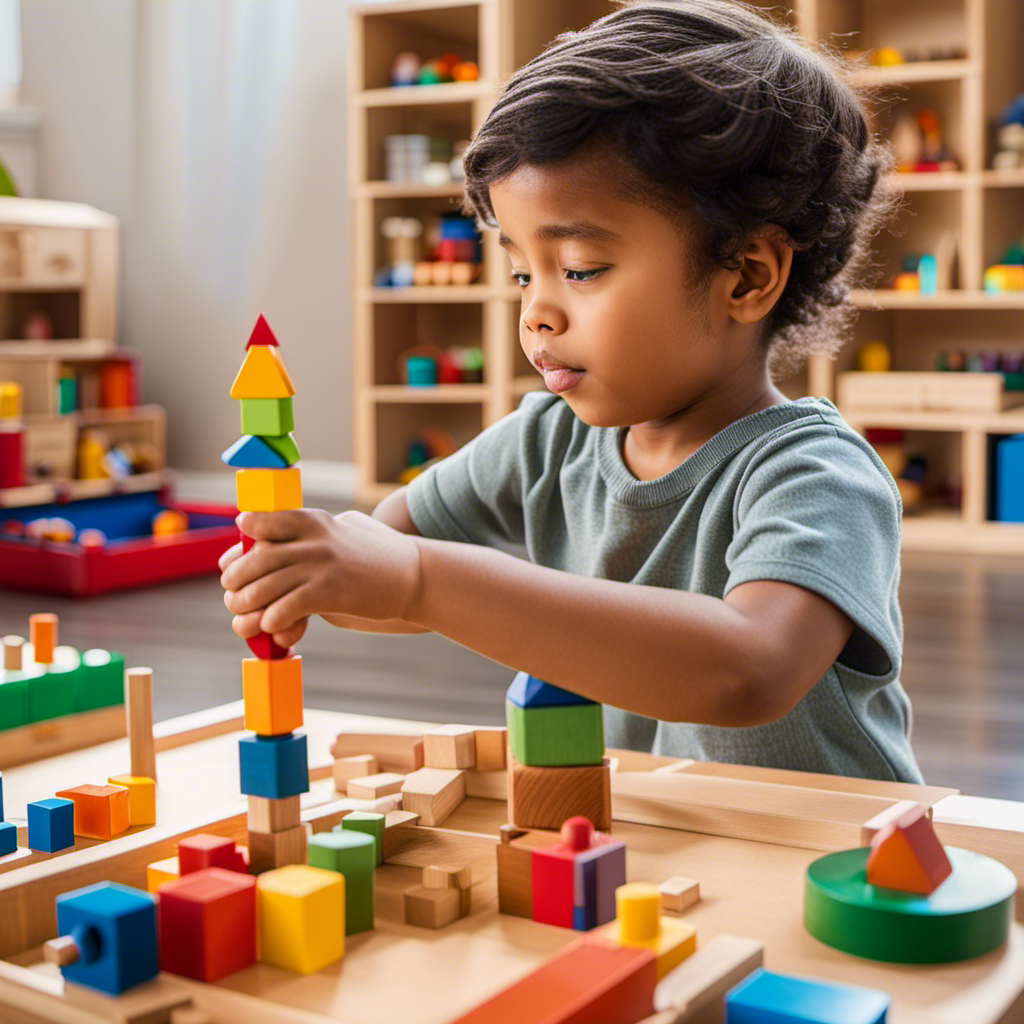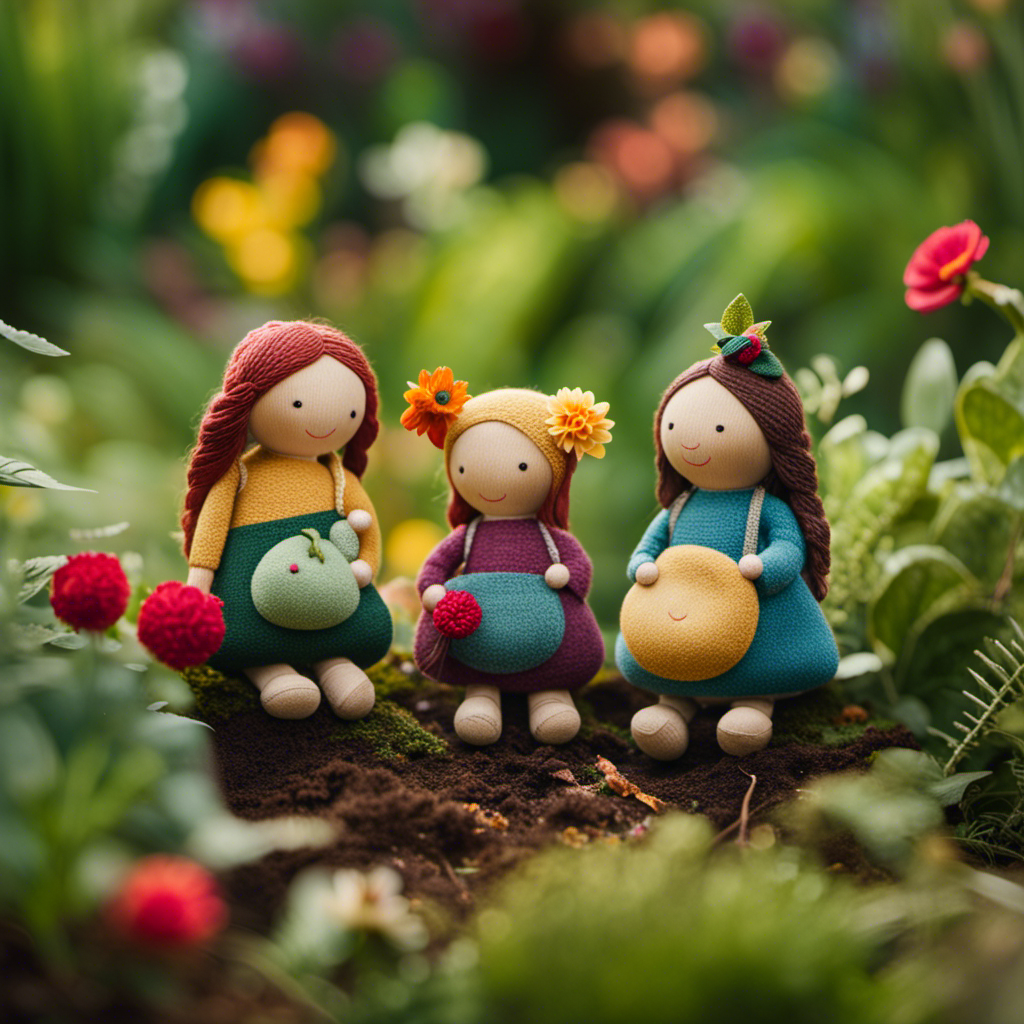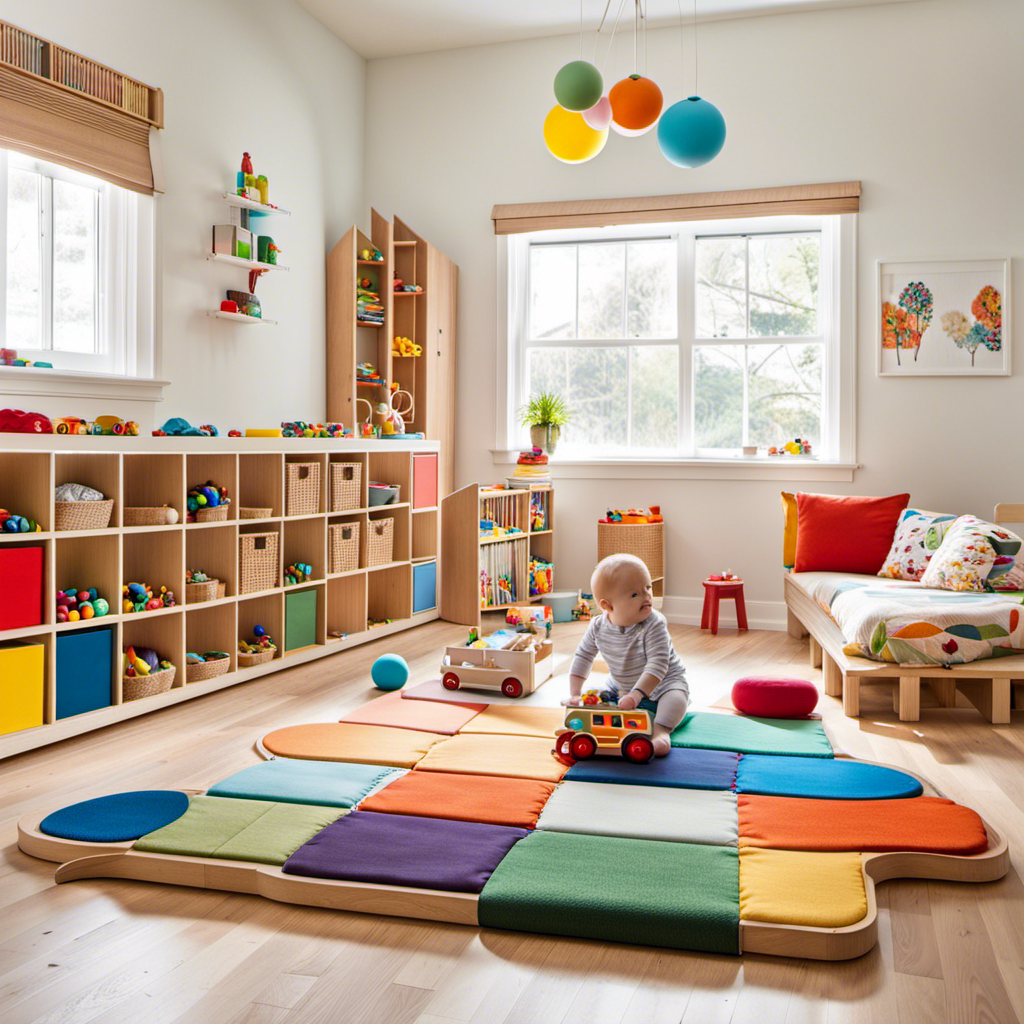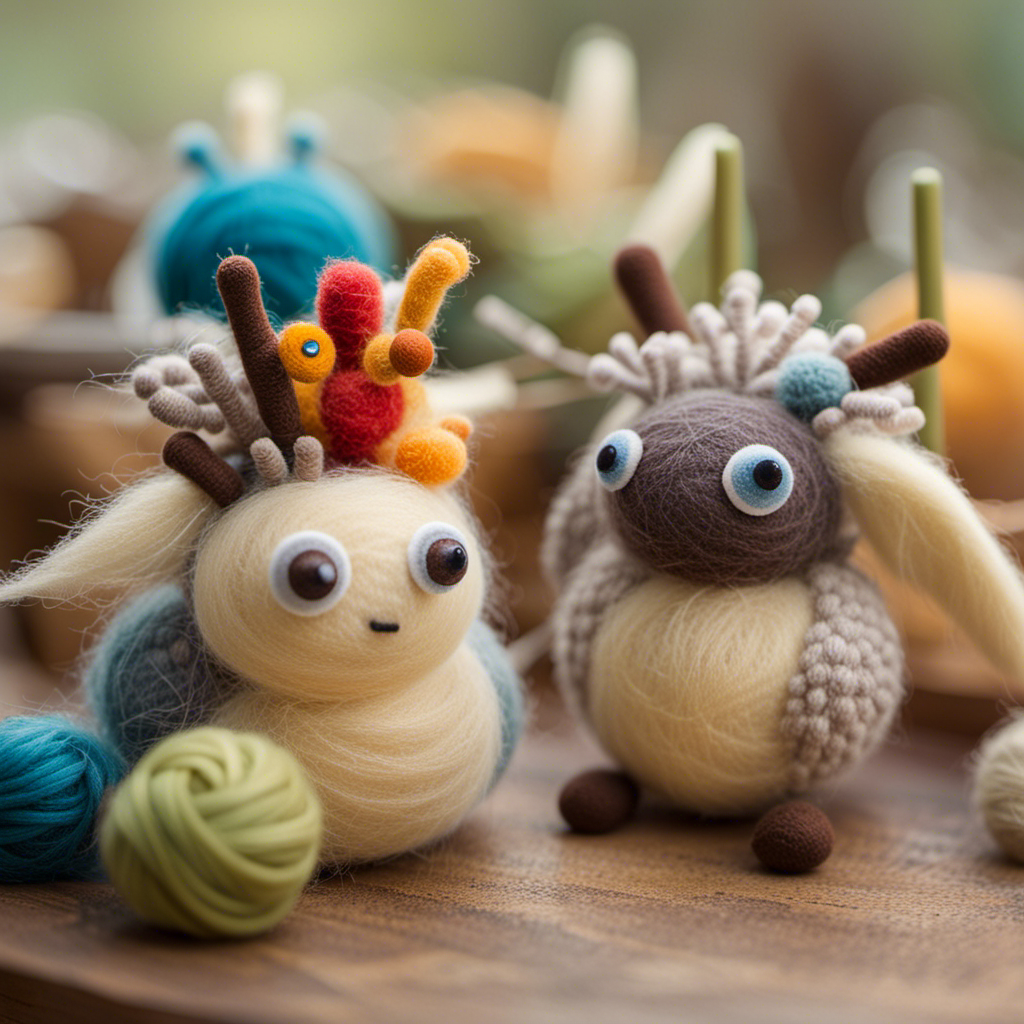As a parent, I am always on the lookout for toys that engage and inspire my child. That is why I am intrigued by Waldorf’s simple toys.
These simple, yet beautifully crafted toys have been gaining popularity for their many benefits. In this article, we will explore why Waldorf plain toys are a great choice for encouraging imaginative play, supporting child development, and limiting screen time.
Join me as we delve into the world of Waldorf plain toys and discover their unique qualities that promote mindful and open-ended play.
Key Takeaways
- Waldorf Plain Toys foster creativity and imagination in children.
- They encourage independent play and stimulate sensory exploration.
- Waldorf Plain Toys promote problem-solving and critical thinking skills.
- They enhance language and communication skills and foster social and emotional development.
The Benefits of Waldorf Plain Toys
The benefits of Waldorf plain toys include fostering creativity and imagination in children. These toys are designed to encourage independent play, allowing children to explore their own ideas and create their own stories. By providing simple and open-ended toys, Waldorf plain toys allow children to use their imagination and come up with endless possibilities.
One of the key benefits of Waldorf plain toys is that they foster sensory exploration. These toys are often made from natural materials such as wood, silk, and wool, which provide a tactile experience for children. They can feel the smoothness of the wood or the softness of the silk, stimulating their sense of touch and enhancing their sensory development.
Furthermore, Waldorf plain toys do not come with a predetermined purpose or function. This allows children to use them in various ways, promoting imaginative play. A wooden block can become a car, a castle, or even a spaceship, depending on the child’s imagination. This type of play encourages children to think creatively, problem-solve, and think outside the box.
In the next section, we will explore how Waldorf plain toys specifically encourage imaginative play and further enhance children’s creativity and development.
Encouraging Imaginative Play With Waldorf Plain Toys
Imaginative play can be encouraged by using these toys. Waldorf plain toys are ideal for fostering creativity and imagination in children. Here are three reasons why these toys are perfect for encouraging imaginative play:
-
Benefits of unstructured playtime: Waldorf plain toys provide children with the opportunity for unstructured play, allowing them to use their imagination and creativity freely. This type of playtime is essential for developing problem-solving skills, social skills, and cognitive abilities.
-
Using natural materials for play: Waldorf plain toys are typically made from natural materials such as wood, silk, and wool. These materials have a sensory appeal and provide a more authentic and tactile experience for children. By engaging with natural materials, children can connect with nature and develop a deeper appreciation for the world around them.
-
Open-ended play possibilities: Waldorf plain toys are intentionally designed to be open-ended, meaning they can be used in various ways and do not have a specific purpose. This allows children to use their imagination and creativity to transform the toys into whatever they desire, whether it’s a castle, a spaceship, or a magical forest.
How Waldorf Plain Toys Support Child Development
You can see how these toys support child development by fostering creativity and imagination. Waldorf plain toys are designed with simplicity and natural materials, allowing children to engage in open-ended play that stimulates their cognitive development. Through imaginative play, children can explore their own ideas, problem-solve, and develop their language and communication skills. Here is a table showcasing the benefits of open-ended play with Waldorf toys:
| Benefits of Open-Ended Play with Waldorf Toys |
|---|
| Enhances creativity and imagination |
| Promotes problem-solving skills |
| Develops language and communication skills |
| Encourages independent thinking |
| Fosters social and emotional development |
As children engage with Waldorf plain toys, they are not limited by predetermined outcomes or structured play. Instead, they have the freedom to create their own narratives, scenarios, and worlds. This type of play allows for self-expression and promotes critical thinking skills. By encouraging children to use their imaginations, Waldorf toys support their overall cognitive development.
Moving forward, it is important to consider the role of Waldorf plain toys in limiting screen time and promoting healthy play habits.
The Role of Waldorf Plain Toys in Limiting Screen Time
When it comes to limiting screen time for children, there are a variety of screen-free play options available that can promote imaginative play.
These options include traditional toys, such as building blocks and dolls, as well as open-ended materials like art supplies and dress-up clothes.
Screen-Free Play Options
There are plenty of screen-free play options available, such as Waldorf plain toys. These toys offer several benefits of unplugged play and can engage children without the need for screens.
Waldorf plain toys are intentionally designed to be simple, yet versatile, allowing children to use their imagination and creativity. They are made from natural materials like wood, and their minimalist design encourages open-ended play. By playing with these toys, children can develop their fine motor skills, problem-solving abilities, and social interactions.
Moreover, screen-free play helps children to focus better, enhances their attention span, and promotes a sense of calmness and mindfulness.
Transitioning into promoting imaginative play, Waldorf plain toys provide a foundation for children to explore their creativity and create their own worlds through play.
Promoting Imaginative Play
Imaginative play can be promoted by providing children with a variety of open-ended toys and materials. These toys allow children to use their imagination and creativity, encouraging pretend play and fostering independent play. By giving children toys that don’t have a specific purpose or set of rules, they are free to use them in any way they choose. This type of play allows children to explore different roles, scenarios, and problem-solving skills. It also helps them develop their language, social, and cognitive skills.
Open-ended toys can include things like blocks, dolls, dress-up clothes, art supplies, and natural materials like sticks and stones. By offering children a range of open-ended toys, we are giving them the opportunity to engage in imaginative play and develop important life skills.
Now, let’s explore the importance of open-ended play with Waldorf plain toys.
Waldorf Plain Toys and the Importance of Open-Ended Play
When it comes to the importance of open-ended play, the benefits are numerous.
Open-ended play allows children to use their imagination and creativity, as there are no rules or specific outcomes to follow.
This type of play also promotes problem-solving skills and helps children develop their own ideas and perspectives.
And when it comes to open-ended play, Waldorf toys are a great tool to encourage creativity and imagination, as they are simple, natural, and allow for endless possibilities.
Benefits of Open-Ended Play
You’ll discover countless benefits when your child engages in open-ended play with Waldorf plain toys. Here are some of the advantages:
-
Encouraging independent play:
Waldorf plain toys do not come with pre-determined rules or outcomes, allowing children to explore and create their own play scenarios. This independence fosters a sense of autonomy and self-confidence in children as they learn to entertain themselves and make decisions. -
Fostering problem-solving skills:
Open-ended play with Waldorf plain toys requires children to think critically and find creative solutions to various challenges they encounter during play. By engaging in imaginative play with these toys, children develop their problem-solving abilities, enhancing their cognitive skills and analytical thinking.
With the freedom to explore and the opportunity to solve problems, open-ended play with Waldorf plain toys provides a solid foundation for your child’s development. It nurtures their independence and problem-solving skills, preparing them for future challenges. This sets the stage for the subsequent section about how Waldorf toys promote creativity.
Waldorf Toys Promote Creativity
To promote creativity, encourage your child to engage in open-ended play with toys that allow them to explore and express their imagination freely. Waldorf toys are perfect for this purpose, as they are designed to encourage innovation and foster independence.
These toys, often made of natural materials such as wood, have a simple and minimalist design that leaves room for children to use their own creativity and imagination. They don’t come with specific instructions or limitations, allowing children to play in whatever way they desire.
By playing with Waldorf toys, children can develop their problem-solving skills, critical thinking abilities, and imaginative thinking. These toys also promote independence, as children are given the freedom to create and explore without relying on predetermined rules or outcomes.
Transitioning into the next section, creating a minimalist toy collection with Waldorf plain toys allows you to provide your child with the tools they need to develop their imagination and creativity.
Creating a Minimalist Toy Collection With Waldorf Plain Toys
If you’re looking to create a minimalist toy collection, consider incorporating Waldorf plain toys into your child’s playtime. These toys are not only aesthetically pleasing, but they also promote open-ended play and creativity. With their simple and natural designs, they can easily fit into any minimalist toy storage system.
When it comes to homeschooling, Waldorf plain toys can be a valuable addition to your curriculum. They allow children to engage in imaginative play and develop their cognitive and fine motor skills. The use of natural materials such as wood, silk, and cotton in these toys also adds a sensory element to the learning experience.
To give you an idea of the variety of Waldorf plain toys available, here is a table showcasing some popular options:
| Toy Type | Description | Benefits |
|---|---|---|
| Wooden blocks | Versatile building toy | Enhances spatial awareness and problem-solving skills |
| Silk scarves | Imaginative play prop | Encourages creative storytelling and role-playing |
| Dolls | Simple and natural dolls | Fosters empathy and emotional development |
Waldorf Plain Toys and the Power of Natural Materials
When choosing toys for your child, opting for those made with natural materials can provide a sensory-rich and eco-friendly play experience. The power of natural materials lies in their ability to engage multiple senses and stimulate creativity. Here are four reasons why natural materials are beneficial for open-ended play:
-
Textural richness: Natural materials like wood, cotton, and wool offer a variety of textures that enhance tactile exploration. The smoothness of wooden blocks, the softness of a handmade doll’s fabric, or the warmth of a woolen ball all contribute to a more sensory-rich play experience.
-
Environmental consciousness: Choosing toys made from natural materials helps reduce our carbon footprint. By supporting eco-friendly manufacturing processes and sustainable sourcing, we can teach children the importance of caring for the planet.
-
Durability and longevity: Natural materials are often more durable than their plastic counterparts, ensuring that toys can withstand years of play. This not only saves money but also reduces waste.
-
Non-toxic and safe: Natural materials are generally free from harmful chemicals, making them a safer choice for children. They eliminate the risk of exposure to toxins commonly found in plastic toys.
By embracing the power of natural materials, we can create a play environment that is both enjoyable and sustainable.
Now, let’s explore the beauty of simple designs in Waldorf plain toys.
Exploring the Beauty of Simple Designs in Waldorf Plain Toys
When it comes to Waldorf plain toys, one cannot help but appreciate the aesthetic appeal of simplicity. The minimalist designs and natural materials used in these toys create a sense of calm and beauty.
Not only do they look pleasing to the eye, but they also offer open-ended play possibilities, allowing children to use their imagination and creativity to the fullest.
Aesthetic Appeal of Simplicity
You’ll appreciate the aesthetic appeal of simplicity when you see how Waldorf plain toys enhance your child’s imaginative play. These toys are designed with minimalistic features, allowing children to use their own creativity to bring them to life.
Here are a few reasons why simplicity is key in Waldorf toys:
-
Simplicity promotes sensory development: The absence of bright colors and complex designs allows children to focus on the textures and shapes of the toys, stimulating their sense of touch and enhancing their sensory development.
-
Waldorf toys encourage open-ended play: With no predetermined functions, children have the freedom to use these toys in countless ways, fostering their imagination and problem-solving skills.
-
Simple designs promote a sense of calm: The understated beauty of Waldorf plain toys creates a peaceful and serene play environment, promoting a sense of tranquility and mindfulness.
-
They inspire creativity: By leaving room for interpretation, these toys encourage children to think outside the box and come up with their own stories and scenarios.
As you explore the open-ended play possibilities of Waldorf toys, you’ll discover a world of endless imagination and wonder.
Open-Ended Play Possibilities
The open-ended play possibilities of these simple toys are limitless, allowing children to explore their imagination and creativity in countless ways. Unstructured play is highly beneficial for children as it fosters their cognitive, emotional, and physical development.
By engaging in open-ended play, children are able to make their own choices, solve problems, and develop critical thinking skills. Waldorf plain toys encourage unstructured play by providing a blank canvas for children to create their own narratives and scenarios.
Additionally, these toys promote sensory exploration, allowing children to engage their senses and develop their fine motor skills. Through touch, sight, and sound, children can discover and understand the world around them.
Nurturing Creativity and Imagination
To nurture your creativity and imagination, try engaging in unstructured play and exploring open-ended possibilities. This type of play fosters innovation and encourages self-expression.
When we engage in unstructured play, we have the freedom to create and imagine without limitations. We can explore different materials, experiment with various ideas, and come up with unique solutions. This process of free play allows us to tap into our creativity and think outside the box.
By encouraging self-expression, we can unleash our inner artist and let our ideas flow freely. Through this process, we can discover new ways of thinking and problem-solving.
Transitioning into the subsequent section about Waldorf plain toys and the value of handmade craftsmanship, we can see how these toys provide the perfect platform for fostering creativity and imagination.
Waldorf Plain Toys and the Value of Handmade Craftsmanship
When it comes to Waldorf plain toys, handmade craftsmanship adds a unique value and charm. These toys are made with love and attention to detail, ensuring that each piece is one of a kind.
Here are three reasons why handmade craftsmanship is so important for Waldorf plain toys:
-
Quality: Handmade toys are crafted with care using high-quality materials, resulting in toys that are durable and long-lasting. The attention to detail in the craftsmanship ensures that the toys are safe and free from any harmful chemicals.
-
Connection to Nature: Waldorf plain toys are often made from natural materials such as wood, cotton, and wool. Handmade craftsmanship allows for the use of sustainable materials that are environmentally friendly. By using natural materials, these toys provide a connection to nature and promote a sense of simplicity and beauty.
-
Unique and Personal: Each handmade toy is unique, with its own individual character and personality. The imperfections and variations in the craftsmanship add to the charm of the toy, making it truly special. Handmade toys also have the personal touch of the artisan, making them more meaningful and cherished by children.
With their handmade craftsmanship and value of simplicity, Waldorf plain toys provide a wonderful foundation for nurturing creativity and problem-solving skills.
Nurturing Creativity and Problem-Solving Skills With Waldorf Plain Toys
By playing with these handmade crafts, you can nurture your creativity and problem-solving skills. Waldorf plain toys are designed to encourage problem-solving abilities and foster imaginative thinking. These toys provide an open-ended play experience that allows children to explore their own ideas and solutions.
When children engage with Waldorf plain toys, they are given the opportunity to use their imagination and think creatively. The simplicity of these toys allows for endless possibilities, encouraging children to think outside the box and come up with unique solutions to problems. Whether they are building with wooden blocks, arranging felt pieces to create scenes, or constructing with natural materials, children are constantly challenged to find new ways to play and create.
Moreover, Waldorf plain toys promote problem-solving skills by presenting children with puzzles and challenges. Whether it’s figuring out how to balance wooden pieces to build a tower or finding the right combination of shapes to complete a puzzle, children are encouraged to think critically and find solutions on their own. This helps develop their problem-solving abilities and enhances their cognitive skills.
In the next section, we will explore the role of Waldorf plain toys in fostering connection and collaboration among children.
The Role of Waldorf Plain Toys in Fostering Connection and Collaboration
As an advocate for Waldorf education, I’ve witnessed firsthand how Waldorf plain toys play a crucial role in promoting social interaction among children. These toys encourage collaborative play, allowing children to engage with one another, develop communication skills, and learn the importance of teamwork.
Additionally, Waldorf plain toys enhance creativity and imagination. They provide open-ended play opportunities, allowing children to explore their own ideas and create their own narratives.
Promoting Social Interaction
To promote social interaction, you can encourage your child to play with Waldorf plain toys. These toys are designed to foster communication skills, build empathy, and enhance social skills in children. Here are five ways playing with Waldorf plain toys can promote social interaction:
-
Encourages cooperative play: Waldorf plain toys are often simple and open-ended, allowing children to engage in imaginative play together, promoting teamwork and cooperation.
-
Stimulates conversation: Playing with Waldorf plain toys encourages children to communicate and express themselves verbally, helping them develop their language and communication skills.
-
Builds empathy: Through pretend play with Waldorf plain toys, children can step into different roles and perspectives, fostering empathy and understanding towards others.
-
Enhances turn-taking skills: Sharing and taking turns with Waldorf plain toys teaches children the importance of waiting their turn and respecting others’ playtime.
-
Promotes problem-solving: Waldorf plain toys often require creativity and problem-solving skills, encouraging children to work together to find solutions.
Enhancing Creativity and Imagination
Playing with open-ended toys can spark imagination and creativity in children. Waldorf plain toys, with their simple designs and lack of specific features, allow children to use their imagination to bring them to life. These toys do not limit a child’s play to a specific storyline or character, but rather encourage them to create their own narratives and scenarios.
By engaging in imaginative play, children are able to explore their own thoughts and ideas, fostering originality and innovation. They can become anyone or anything they want to be, whether it’s a superhero saving the world or a chef cooking up a storm. This type of play not only enhances their creativity but also helps them develop problem-solving skills and the ability to think outside the box.
As children engage with these toys, they are building the foundation for their future imaginative and innovative endeavors.
Moving on to the development of fine motor skills, Waldorf plain toys provide the perfect opportunity for children to refine their coordination and dexterity.
Waldorf Plain Toys and the Development of Fine Motor Skills
The use of Waldorf plain toys can enhance the development of fine motor skills in children. Fine motor skills refer to the coordination of small muscles in the hands and fingers, which are essential for activities such as writing, drawing, and buttoning clothes. Waldorf plain toys provide a unique opportunity for children to engage in sensory exploration, which further supports the development of these skills.
Through play with Waldorf plain toys, children are encouraged to manipulate and interact with objects using their hands. Whether it’s stacking wooden blocks, threading beads onto a string, or fitting puzzle pieces together, these activities require precise hand-eye coordination and dexterity. The simplicity of Waldorf plain toys allows children to focus on the task at hand, honing their fine motor skills in a focused and deliberate manner.
Furthermore, the sensory exploration aspect of Waldorf plain toys adds another dimension to the development of fine motor skills. The different textures, shapes, and weights of these toys provide sensory feedback, stimulating the child’s senses and enhancing their tactile perception. This sensory exploration not only improves fine motor skills but also promotes cognitive development and spatial awareness.
In a fast-paced world where technology dominates, embracing the simplicity of Waldorf plain toys can provide a much-needed balance for children. These toys allow them to engage in open-ended play, fostering creativity, imagination, and problem-solving skills. By encouraging the development of fine motor skills through Waldorf plain toys, we are not only supporting their physical growth but also nurturing their overall development in a holistic and meaningful way.
Embracing the Simplicity of Waldorf Plain Toys in a Fast-Paced World
As we explore the benefits of Waldorf plain toys, it is important to consider how they can fit into our modern parenting approach. In today’s fast-paced world, where technology and flashy toys dominate the market, finding balance with Waldorf plain toys can be a refreshing change.
Incorporating these simple and natural toys into our children’s lives allows them to engage in open-ended play, fostering their creativity and imagination. The absence of bells and whistles encourages children to rely on their own abilities and ideas, promoting problem-solving skills and independent thinking.
Waldorf plain toys also offer a respite from the overstimulation that children often face in our digital age. The calming, sensory experience of playing with these toys can help children unwind and find a sense of peace in their playtime.
As a parent, I have found that embracing the simplicity of Waldorf plain toys has allowed me to connect with my child on a deeper level. By engaging in play that is focused on imagination and storytelling, we have created moments of joy and shared experiences that are truly priceless.
Transitioning into the next section about Waldorf plain toys and the promotion of mindful play, it is important to understand how these toys can encourage mindfulness in our children’s lives.
Waldorf Plain Toys and the Promotion of Mindful Play
Incorporating these simple and natural toys into our children’s lives can cultivate mindfulness and encourage them to be present in their playtime. Mindful parenting is about being fully engaged and aware in the moments we spend with our children, and choosing toys made from natural materials can support this practice.
Here are some benefits of incorporating natural materials into our children’s play:
-
Sensory stimulation: Natural materials like wood, cotton, and wool engage multiple senses, allowing children to fully experience the textures, smells, and sounds of their toys.
-
Connection to nature: Playing with toys made from natural materials can help foster a deep connection to the natural world, encouraging children to appreciate and care for the environment.
-
Durability: Natural toys are often sturdier than their plastic counterparts, lasting longer and reducing waste.
-
Open-ended play: Simple toys without batteries or complicated features allow children to use their imagination and creativity, promoting problem-solving skills and independent thinking.
-
Health and safety: Natural materials are non-toxic and free from harmful chemicals, providing a safe and healthy play environment for children.
Investing in Long-Lasting Quality With Waldorf Plain Toys
Invest in long-lasting quality by choosing toys made from natural materials that encourage mindful play.
Investing in sustainable play is not only beneficial for the environment, but it also promotes creativity, imagination, and problem-solving skills in children.
When we opt for toys made from natural materials such as wood, cotton, or wool, we are investing in items that are durable and can withstand years of play.
These toys are often open-ended, meaning they do not have a specific purpose or set of instructions. Instead, they allow children to use their imagination and creativity to play in a variety of ways.
Open-ended toys have a way of growing with the child, adapting to their changing interests and abilities. They encourage independent play, as children are not limited by predetermined rules or outcomes.
This type of play promotes critical thinking and problem-solving skills, as children learn to navigate and explore their environment.
Frequently Asked Questions
Are Waldorf Plain Toys Suitable for Children With Special Needs?
Yes, Waldorf plain toys can be suitable for children with special needs. These toys support special needs by promoting open-ended play, allowing children to use their imagination and creativity.
The simplicity of Waldorf plain toys fosters sensory exploration and encourages problem-solving skills. They are free from overwhelming lights, sounds, and distractions, making them ideal for children who may be easily overstimulated.
Additionally, these toys can help develop fine motor skills and provide a calming and therapeutic experience for children with special needs.
Can Waldorf Plain Toys Be Used in a Classroom or Group Setting?
In my experience, Waldorf plain toys have proven to be incredibly effective in a classroom or group setting. The inclusion benefits are undeniable, as these toys promote equal participation and engagement among all children.
They encourage imaginative play and foster creativity, allowing children to explore their own unique interests and abilities. The simplicity of these toys also encourages collaboration and cooperation, as children can easily share and interact with one another.
Overall, Waldorf plain toys are a wonderful addition to any classroom.
Do Waldorf Plain Toys Require Any Maintenance or Special Care?
Maintenance requirements for Waldorf plain toys are minimal. They are designed to be durable, ensuring longevity in a classroom or group setting. Regular cleaning with mild soap and water is usually sufficient. Avoid exposing the toys to excessive moisture or heat, as this can damage the natural materials. Additionally, it is important to store them in a dry place when not in use.
With proper care, Waldorf plain toys can last for many years, providing endless opportunities for open-ended play.
Are There Any Specific Age Recommendations for Waldorf Plain Toys?
There are specific age recommendations for Waldorf plain toys. These toys are designed to stimulate a child’s imagination and encourage open-ended play. They are suitable for children of all ages, from infants to older kids.
The simplicity and lack of detail in Waldorf toys allow children to project their own ideas onto them. This promotes creativity, problem-solving skills, and independent play.
It’s important to choose toys that are developmentally appropriate for each child’s age and stage of development.
Where Can I Purchase Waldorf Plain Toys?
There are several online retailers where you can purchase Waldorf plain toys. They offer a wide range of options for different age groups and interests.
One benefit of using Waldorf plain toys for imaginative play is that they encourage open-ended play, allowing children to use their creativity and imagination.
These toys are made from natural materials and have a simple design, which helps to stimulate a child’s senses and promote a sense of calm and focus during playtime.
Conclusion
In conclusion, Waldorf Plain Toys offer numerous benefits for children’s development. They encourage imaginative play, limit screen time, and promote open-ended play, all while developing fine motor skills.
These toys provide a much-needed respite from the fast-paced world we live in, allowing children to engage in mindful play. It is interesting to note that a study conducted by the American Academy of Pediatrics found that children who engage in imaginative play with simple toys have been shown to have lower levels of stress and anxiety.
This statistic highlights the importance of investing in quality, long-lasting toys that foster creativity and emotional well-being.
Tina is the heart and soul behind Toddler Ride On Toys. With a passion for early childhood education and a deep understanding of child development, Tina ensures that every piece of content on our website reflects our commitment to playful learning. Her expertise in Montessori, Preschool, STEM, and Waldorf education philosophies helps shape our website into a valuable resource for parents, caregivers, and educators.











